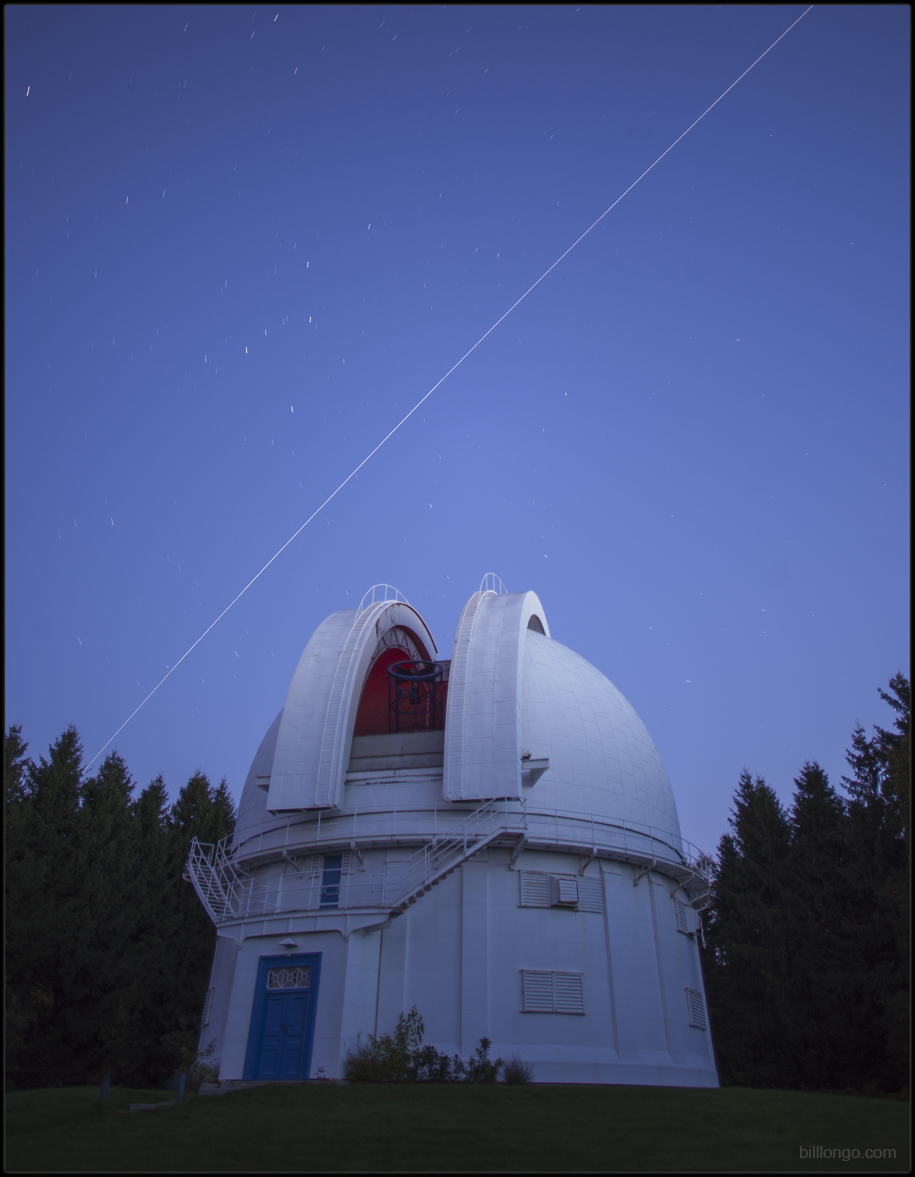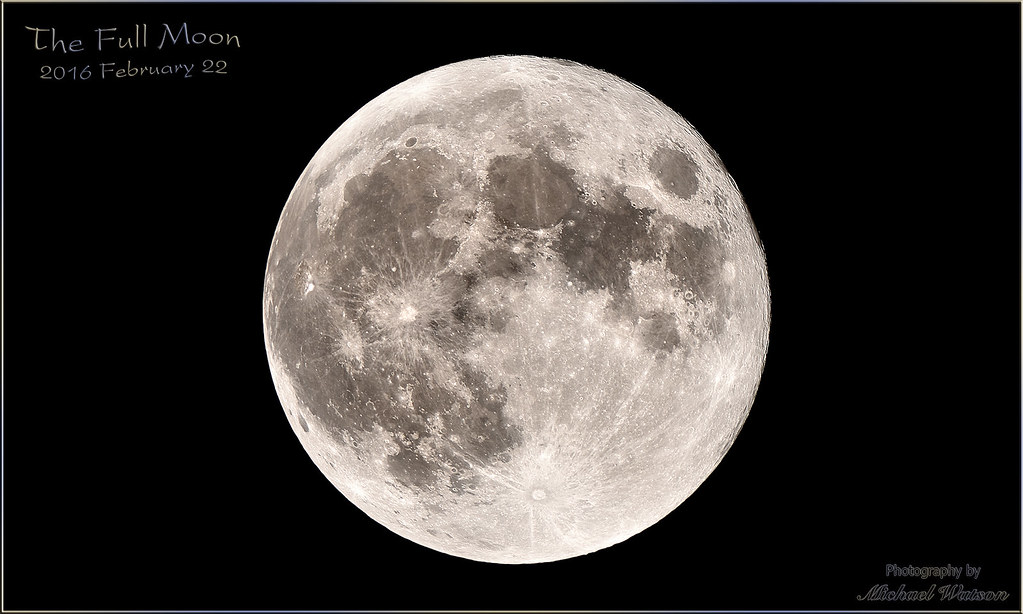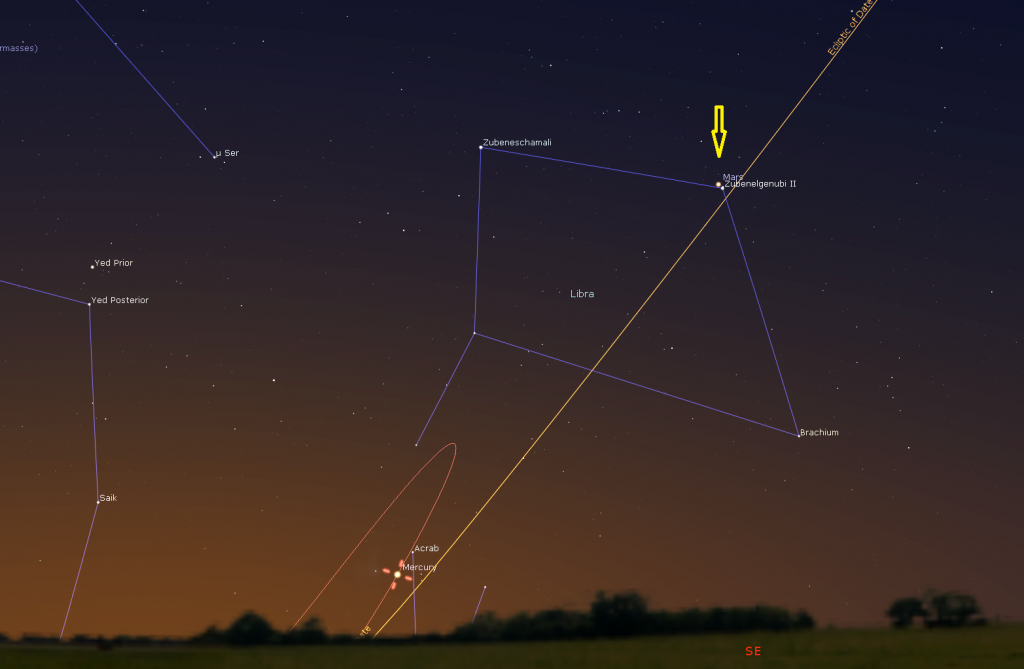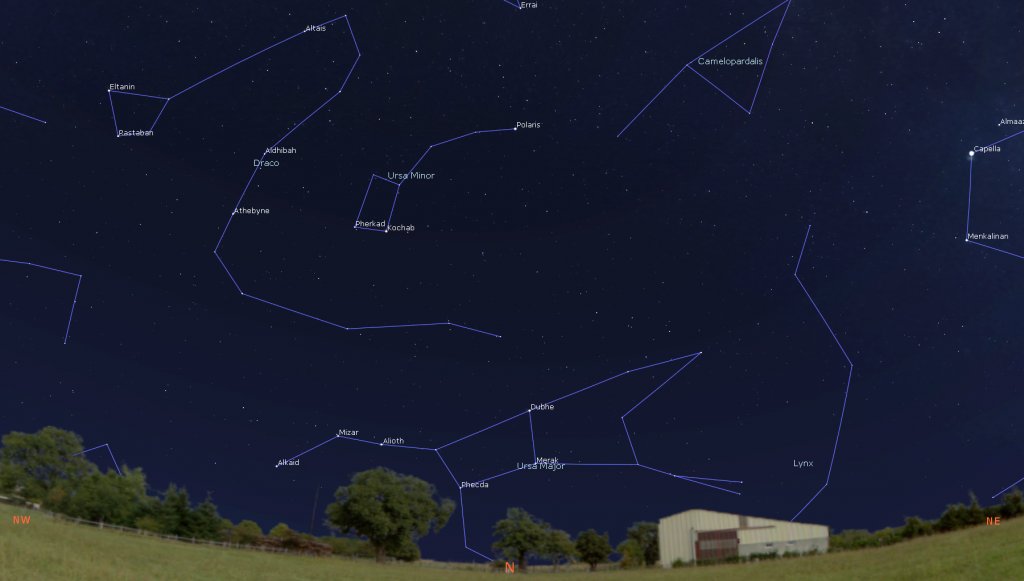Spotting Satellites, Venus Veers past Saturn, Mars Snuggles a Double Star, and Full Moonlight Floods the Night Sky!

This long exposure image by Bill Longo of Toronto shows the trail produced by the International Space Station when Expedition 41 flew over the David Dunlap Observatory in 2014. Bill’s gallery of beautiful images can be explored at https://interceptedphotons.com/
Happy December, Stargazers!
Here are your Astronomy Skylights for the week of December 8th, 2019 by Chris Vaughan. Feel free to pass this along to your friends and send me your comments, questions, and suggested topics. I repost these emails with photos at http://astrogeo.ca/skylights/ where all the old editions will be archived. You can also follow me on Twitter as @astrogeoguy! Unless otherwise noted, all times are Eastern Time. To subscribe to these emails please click this MailChimp link.
I can bring my Digital Starlab portable inflatable planetarium to your school or other daytime or evening event. Contact me through AstroGeo.ca, and we’ll tour the Universe together!
While it transitions through its full phase, the moon will shine brightly in the night-time sky the world over this week. Extremely bright Venus will dance with dimmer Saturn after sunset. In the pre-dawn Mercury will remain in sight in the eastern sky while descending sunward – and reddish Mars will snuggle up to a bright double star. Look out – a bear is stalking the northern horizon. Here are your Skylights!
Spotting Satellites
Artificial satellites are visible because they are high enough to be bathed in sunlight while the sun is below the horizon for earthbound observers. When the geometry is just right, brilliant beams of sunlight are reflected to Earth from flat, shiny surfaces on the spacecraft – which we see as a steady point of light that crosses the night sky in mere minutes.
Low Earth orbiting satellites like the space station can only be seen within an hour or two of dusk and dawn (even though they are passing overhead at all hours of the day and night). On rare occasions they can be observed silhouetted against the disks of the moon or sun. Satellites with higher orbits can be seen throughout the night.

Geostationary satellites such as telecom and satellite television transmitters need to broadcast toward specific regions of the Earth, so they are placed in very remote orbits that hold them fixed at a specific altitude and azimuth in the sky. They require a telescope to see them. They will appear as tiny dots that are anchored in place while the background stars drift past them due to Earth’s rotation.
Engineers do not bother attaching lights to satellites. If you see a night sky object that has flickering or flashing lights, it’s an aircraft. Decommissioned satellites and space “junk”, such as spent rocket boosters, can smoothly vary in brightness if they are tumbling.
The two best websites for satellite predictions are www.heavens-above.com and www.calsky.com. At Heavens-Above, click the Location link and enter your geographic location – manually, or by dropping a pin on the provided map. Then return to the main page and select from the provided list of object types, such as “ISS”.
CalSky.com guesses your location. For satellites, it’s a good idea to enter an accurate location. Once done, click the Satellites tab (under the website title) and then choose one of the available functions. For example, to see when the space station will fly over your location, click “Internat. Space Station ISS”.
Another fantastic Calsky option is a list of predictions of when, for your location, the space station will pass across the disk of the sun or moon. Set the start of calculation (or click “Now”) and then set the duration to search within. I use one or two weeks. By default the software will list the near misses, too – assuming that you are willing to drive a little ways to see a pass. You can also have the website send you alerts for future events. Remember that seeing or photographing satellite passes across the sun’s disk will require proper solar filters.
Apps such as Sputnik!, ISS Detector, and Orbitrack will put satellite predictions in your pocket, alert you of imminent passes, and even show you where to look. The SkySafari app also includes an extensive satellite database.
The Moon and Planets
The moon will continue to dominate evening skies worldwide this week. As the moon waxes fuller the eastern side of the moon’s round face will be dramatically lit by slanted sunlight along the terminator – the pole-to-pole zone that divides the moon’s lit and dark hemispheres. Scan your binoculars along that strip of the moon, and then look again on subsequent nights to view new terrain in stark relief.

Tonight (Sunday) will find the moon just above (or to the celestial north of) the dim stars that form the head of Cetus (the Whale). The bright moon will do them no favours, but the large main belt asteroid Vesta (shining at magnitude 7.9) and distant Uranus (shining at a somewhat brighter magnitude 5.7) will be situated about a palm’s width below and above the moon, respectively. To better see either of those objects, take note of the stars nearby and wait a few nights for the moon to leave the area.
Starting on Tuesday evening and lasting until dawn, the nearly full moon will pass just to the north of the stars making up the triangular face of Taurus (the Bull). The bright star Aldebaran, which marks the bull’s more southerly eye, will still be visible against the moon’s brilliance. Due to Taurus’ position just south of the Ecliptic, the moon passes near, or through, his face every month.
On Wednesday night, the moon will move to sit between the horns of Taurus and then reach its full moon phase at 12:12 am EST (05:12 UT or Greenwich Mean Time) on Thursday. The December full moon, traditionally known as the Oak Moon, Cold Moon, Long Nights Moon, and the Moon Before Yule, always shines in or near the stars of Taurus. Since it’s opposite the sun on this day of the lunar month, the moon becomes fully illuminated, and rises at sunset and sets at sunrise. Full moons during the winter months at mid-northern latitudes reach as high in the sky as the summer noonday sun, and cast similar shadows.
Indigenous people have their own names for the full moons, which marked time and lit the way of the hunter or traveler at night before modern conveniences like flashlights. The Ojibwe of the Great Lakes region call the December full moon Mnidoons Giizis, the “Blue Moon” or “Big Spirit Moon”. For them it is a time of purification and of healing of all Creation. The Cree of North America call it Thithikopiwipisim, the “Hoar Frost Moon”, when frost sticks to leaves and other things outside.
On Thursday evening, the just-past-full moon will also pass within two finger widths to the lower right (or 2 degrees to the celestial south) of the rich, open star cluster named Messier 35. To see that cluster’s stars despite the bright moonlight, position the moon just outside your binoculars’ or telescope’s field of view.
For the rest of the week, the moon will wane in phase and rise in mid-evening – allowing it to linger into the morning sky.

We lose Jupiter within the evening twilight this week, but Venus and Saturn will remain to dance in the western sky after sunset. Venus’ orbit is currently drawing it away from the sun while Saturn is being carried west towards the sun by Earth’s motion. On Tuesday and Wednesday (December 10-11), ascending Venus will pass less than two finger widths to the lower left (or less than 2 degrees to the celestial south) of Saturn. Extremely bright, magnitude -3.9 Venus will greatly outshine magnitude 0.58 Saturn, but the pair will make a gorgeous sight to unaided eyes, in binoculars, and in backyard telescopes at low magnification. Both planets will set shortly before 7 pm local time this week.
This winter, evening planet-watchers will have to settle for Venus and the ice giant planets Uranus and Neptune. Despite their relatively dim magnitudes and small disk sizes, the delightful colours of those two remote planets make them worthy of a look in backyard telescopes – although they can be tricky to find.
Distant and dim, blue Neptune will set just before midnight local time this week, so you should try to observe it while it is highest in the sky – at 6 pm local time. Neptune is situated among the stars of eastern Aquarius (the Water-Bearer), and is positioned a thumb’s width to the right (or 1.5 degrees to the celestial west) of a medium-bright star named Phi (φ) Aquarii. Both blue Neptune and that golden-coloured star will appear together in the field of view of a backyard telescope at low power. When the bright moon is out of the night sky next week, magnitude 7.9 Neptune will be visible in binoculars. Find Phi Aquarii first and then locate nearby Neptune. Remember that binoculars will display the true positions of the objects, but your telescope will flip and/or mirror-image the view. (To find out what your telescope does to the image, see how it changes the appearance of the moon.)

Blue-green Uranus is located a generous palm’s width to the left (or 7 degrees to the celestial east) of the modest stars that form the “V” of Pisces (the Fishes). It’s also below (or to the celestial south of) the medium-bright stars of Aries (the Ram), and above the head of Cetus.
Uranus is observable from dusk until the wee hours of the night. Shining at magnitude 5.7, it is bright enough to see with or without binoculars under dark skies – and through small telescopes any time. To help you find it, I posted a detailed star chart here. If you view it at about 9 pm local time, it will be highest in the sky – and you’ll be looking through the least amount of Earth’s disturbing atmosphere.
Mercury and Mars are still putting on a show in the eastern pre-dawn sky. This week Mercury will be exiting the scene due to its descent sunward. You can look for medium-bright Mercury sitting very low over the southeastern horizon between 6:45 and 7 am local time.

Red-tinted Mars will rise at about 4:45 am local time and remain visible until dawn. On Thursday morning, Mars will pass very close to the medium-bright, white double star Zubenelgenubi in Libra (the Scales). The planet and the two stars will easily fit within the field of view of a telescope at medium magnification.
From now until October, 2020, Mars will continually grow in brightness – and will increase in apparent size when viewed in telescopes. In fact, the 2020 Mars opposition will be a terrific excuse to get a telescope now so you can practice viewing the planet during the spring and summer months of 2020! If you missed last week’s information about buying a beginner telescope, I posted it here.
The Great Bear Prowls the North
While the moon is near-full this week, the brightest stars will still be able to catch your eye. If you live north of 40° N latitude, face north after dark and look just above the horizon for the seven stars of the Big Dipper. It will be extended left-right along the horizon – or tilting upward to the east if you look later in the evening. All of the dipper’s stars have a similar brightness near 2nd magnitude. The Big Dipper asterism is only part of the larger constellation of Ursa Major (the Big Bear). But the bear’s legs will be hidden below the horizon.
The North Star, more formally known as Polaris, is located three fist diameters (or 30 degrees) away from the outer rim of the Big Dipper’s bowl, which is marked by the star named Dubhe. You can use the Dubhe and the star Merak, which marks the lower corner of the bowl, to find modest Polaris. Start at Merak and draw an imaginary line through Dubhe and beyond. The first reasonably-bright star you arrive at is Polaris (ranked 44th in brightness among stars).

During early December after dusk, Polaris always sits directly above the dipper. But every three months, the dipper rotates by 90° in the sky. On summer evenings, the dipper is nearly overhead, and Polaris sits below it. At that time of the year, anyone on Earth living north of 30° South latitude can see the Big Dipper – but not the North Star.
Meteor Shower News
The Geminids Meteor Shower, always one of the most spectacular of the year, runs from December 4 to 16 annually – so you can begin to watch for Geminids this week. This shower will peak before dawn on Saturday, December 14, when up to 120 meteors per hour are possible under dark sky conditions. Geminids meteors are often bright, intensely coloured, and slower moving than average because they are produced by particles dropped by an asteroid designated 3200 Phaethon.
The full moon in Gemini on the peak night will overwhelm the majority of the meteors for this shower in 2019. Head outside on a clear evening early this week to catch a few while the moonlight is less intense!
The best time to watch for Geminids will be after midnight – but you can start looking for them after full evening darkness sets in. At about 2 am local time, the sky directly overhead, which will be positioned near the bright star Castor in Gemini (the Twins), will be plowing into the densest part of the debris field. True Geminids will travel away from that part of the sky, but don’t just watch that location – the meteors will be shortest there, and they can appear anywhere in the sky.
To see the most meteors, find a wide-open, dark location, preferably away from light polluted skies, and just look up with your unaided eyes. Binoculars and telescopes are not useful for meteors – their field of view are too narrow. Try not to look at your phone’s bright screen – it’ll ruin your night vision. And keep your eyes heavenward, even while you are chatting with companions. If the peak night is cloudy, a few nights on either side of that date will be almost as good. Happy hunting!
Public Astro-Themed Events
At 7:30 pm on Wednesday, December 11, the RASC Toronto Centre will hold their free monthly Recreational Astronomy Night Meeting at the Ontario Science Centre, and the public are welcome. Talks include The Sky This Month, astrobiology in France, and astrophotography from Australia. These meetings are also streamed live on RASC-TC’s YouTube channel. Check here for details. Parking is free.
Every Monday evening, York University’s Allan I. Carswell Observatory runs an online star party – broadcasting views from four telescopes/cameras, answering viewer questions, and taking requests! Details are here. On Wednesday nights they offer free public viewing through their rooftop telescopes, including their brand new 1-metre telescope! If it’s cloudy, the astronomers give tours and presentations. Registration and details are here.
If it’s sunny on Saturday morning, December 7 from 10 am to noon, astronomers from the RASC Toronto Centre will be setting up outside the main doors of the Ontario Science Centre for Solar Observing. Come and see the Sun in detail through special equipment designed to view it safely. This is a free event (details here), but parking and admission fees inside the Science Centre will still apply. Check the RASC Toronto Centre website or their Facebook page for the Go or No-Go notification.
This Winter spend a Sunday afternoon in the other dome at the David Dunlap Observatory! On Sunday afternoon, January 12, from noon to 4 pm, join me in my Starlab Digital Planetarium for an interactive journey through the Universe at DDO. We’ll tour the night sky and see close-up views of galaxies, nebulas, and star clusters, view our Solar System’s planets and alien exo-planets, land on the moon, Mars – and the Sun, travel home to Earth from the edge of the Universe, hear indigenous starlore, and watch immersive fulldome movies! Ask me your burning questions, and see the answers in a planetarium setting – or sit back and soak it all in. Sessions run continuously between noon and 2 pm, and repeat from 2 to 4 pm. Ticket-holders may arrive any time during the program. The program is suitable for ages 3 and older, and the Starlab planetarium is wheelchair accessible. For tickets, please use this link.
Keep looking up, and enjoy the sky when you do. I love questions and requests – so, send me some!